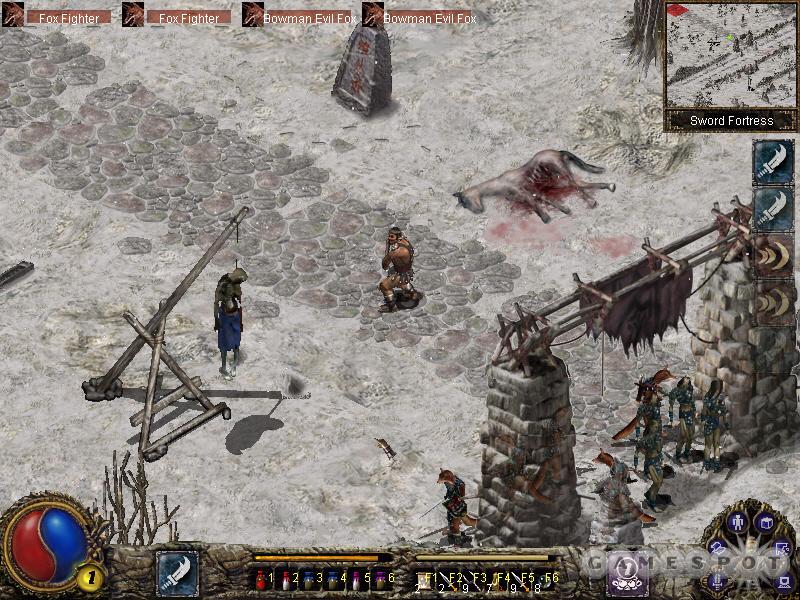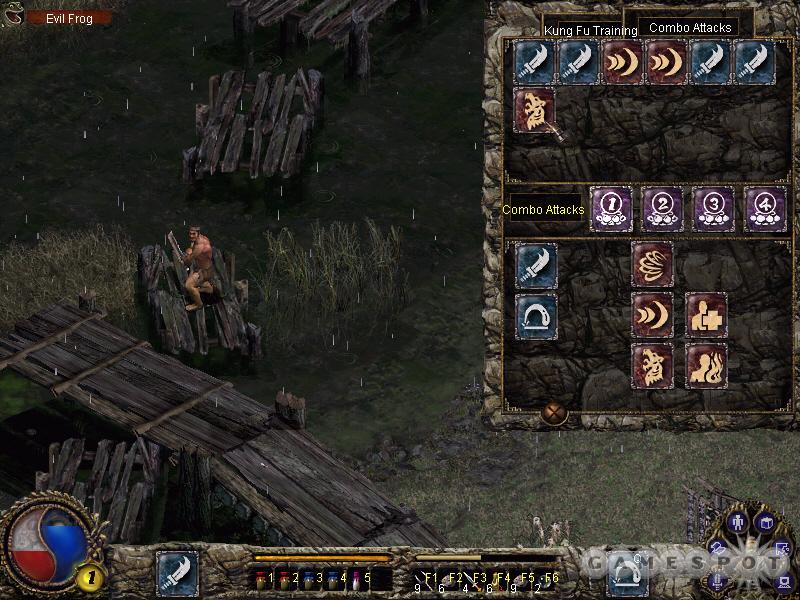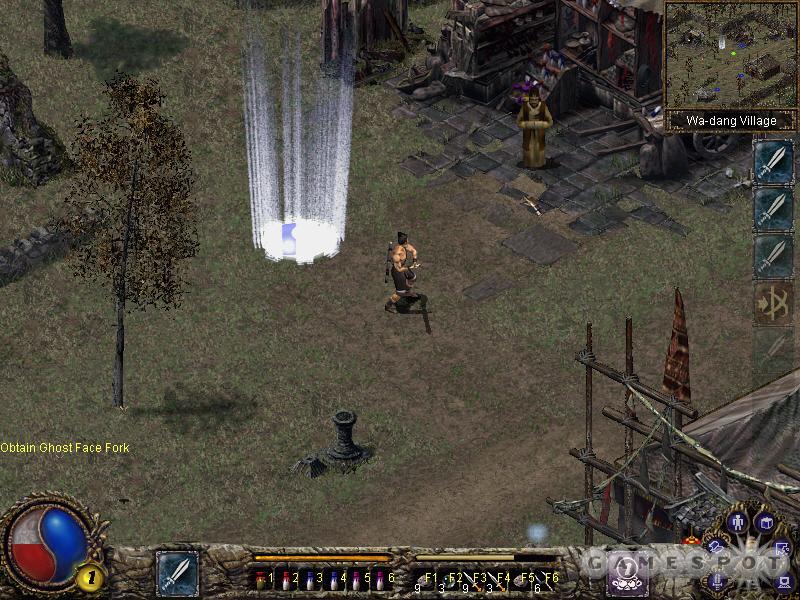Blade and Sword is a Diablo-style action role-playing game set in China. It has a heavy emphasis on fighting-game elements such as combos, special attacks, and blocking. The game actually pulls off these aspects really well and can be exciting at times. Unfortunately, a poor translation, very repetitive gameplay, and a lack of any multiplayer features mar what otherwise could have been an excellent take on this type of game.

Blade and Sword takes place 3,000 years in the past, albeit in an alternate past. It's difficult to make out exactly what is happening in the story, though, due to a poor English translation from the original Chinese. There's something about emperors and wars, but all you really need to know is that there's an evil wizard that you need to stop. Wizard Wen has opened rifts between three realms, and so creatures from the human, beast, and demon realms can now mingle freely. As such, all sorts of foul monsters have come to terrorize humankind, and it's up to you to figure out exactly what's wrong and how to fix it. Rather, it's up to you to kill a whole bunch of monsters single-handedly.
You can choose one of three heroes to step up to the task. The three heroes aren't created equal though. The long-swordsman is the average, balanced character. He can stun a group of enemies and move in for the attack, so he is the easiest to play as. The twin-blades heroine is fast and agile, and while she isn't as powerful as the other two heroes, she does have a secondary kick attack. The great-blade warrior is very strong, but he isn't as coordinated as his fellow comrades. The latter two heroes are more difficult to play as because you have to put forth more effort to control them due to their abilities and skill sets. Each hero has a unique set of skills, which are divided into four categories, and each category has a progression of three skills, followed by a super skill. Each skill (except for the super skills) can be upgraded twice to make it more powerful. As with similar games with skill tress, you gain one point every level, and you may distribute any accrued points whenever and however you wish.
Unlike in Diablo II, for example, you'll get every skill by the end of Blade and Sword. The upside is that you won't be penalized for diversifying your character as in Diablo II, in which characters with a variety of skills are much weaker than characters with a focus on particular skill sets. The downside is that you can't create a unique character. There's no mystery about what some other skill path may have given you, and so there's not much incentive to try playing the same character in a different fashion. And that's only the beginning. When you level up, the game automatically upgrades your ability scores. That means you can't make your character more powerful in one area if you're inclined. Since the character-building aspects of Blade and Sword are really quite limited, you'll never feel very attached to your character, nor does the game offer much replay value. 
This identity crisis is further compounded by the fact that you don't scavenge for weapons. Part of the appeal of role-playing games is finding new equipment for your characters. However, you don't equip your character in Blade and Sword. You'll never put on better armor or find a stronger sword. That's a shame--it's not very exciting to never get to upgrade your arsenal. For what it's worth, you can slightly upgrade and customize your character with gems, which bestow benefits like extra damage or higher defense and are dropped by slain enemies or found in the environment.
A game had better have something to keep you interested if there isn't bountiful loot, and fortunately, Blade and Sword does have something up its sleeve. Most of the skills in the skill tree are special attacks that you can perform. For example, the twin-blade heroine can do a move that involves kicking at an enemy three times consecutively. The special attacks aren't incredibly powerful on their own, but they can be devastating when used in combinations. Your normal attack may only reduce an enemy's health by a small amount, while a combination can slice through the same enemy's entire life gauge. That's because enemies will fall down if they are hit by the same type of attack repeatedly, preventing you from pursuing the attack until they regain their footing. For example, the great-blade warrior will drop an enemy if he hits it with three normal attacks, and that enemy will probably get back up. Instead, you can string together special attack combinations to inflict a lot of damage without knocking down the opponent. The great-blade warrior can make a combination like this: two normal attacks, two triple-strike attacks, two more normal attacks, one dragon lift, one more triple strike, one normal attack, and then a smash throw. Fortunately the game allows you to make four combo shortcuts, so you could do that entire sequence by just pressing the right mouse button instead of manually changing attacks.
You need to be careful when executing combos, though, because most enemies can defend against your attacks. You can defend against attacks as well. Simply hold down the Alt key, and you'll deflect blows at the expense of stamina. The special attacks and defending are a welcome addition to the action RPG genre because these things actually involve you in the action.

You can also execute a super attack once you gain the three skills in a set. You hold down the Ctrl or Alt buttons and trace a pattern using your mouse. They aren't complex to draw--the patterns consist of slash-shaped or M-shaped marks--and they can be used when you build up enough power. They can be quite devastating when used properly. For example, the great-blade hero has a super power called the lion storm, which will instantly kill most creatures. This is easier said than done, though, because you have to spend time tracing and then charging up for the attack. And if you're disrupted, you'll lose the 1,000 power points required to cast it. Everything else about Blade and Storm is clearly derived from Diablo II. The game's interface is nearly identical: You use the left mouse button to attack and the right mouse button to control the special moves. There are portals that quickly teleport you to areas once you activate them. There is even a cube that transmutes items; for example, it will transform three common amber gems into one refined amber gem. So, anyone who has devoted time to the Diablo series will feel at home in Blade and Sword. The main problem with Blade and Sword is that there isn't anything that will hold your attention in the long run. The game is single-player-only and will last you about 20 hours in your first run. The obtuse storyline coupled with a practically nonexistent treasure hunt means that Blade and Sword solely depends on combat to keep you coming back for more. But the combat gets tiresome after a while and is very repetitive, especially after you find a combo that works particularly well. You'll end up running past groups of enemies in subsequent replays because you just don't want to deal with the time and effort required to kill them--not a very good sign for a game attempting to get you involved in the action.
At least Blade and Sword features a large selection of monsters to fight. The AI does a good job of keeping you on your toes--you'll have to use your parry and sidestep abilities in order to stay alive. In fact, the game can be quite difficult at times. Some enemies will wait until you're deep into a combo against another foe before rushing in behind you and attacking. That breaks up the combo and leaves you surrounded by foes. Since you can only block attacks to your front, you'll have to retreat and try again. One of the enemies in particular, the king hawk, is incredibly frustrating because he has high hit points and can't be attacked while he is in the air--you can hit him only when he swoops down to attack you. This wouldn't be a problem except that he will hit you even if you're several steps to his right or left. The poor hit detection makes it a long and irritating battle. You'll hardly ever encounter a lone enemy, so the repetition sets in as you try to draw one enemy away from a crowd and kill it.

Blade and Sword has some decent graphical and sound effects that excel in some areas but falter in others. The environments and models don't really stand out, although the terrain does change every few stages. The animations aren't up to today's standards, especially when the characters jump or launch an enemy into the air. But you won't notice it too much because, unlike in most other games, your swords are actually sharp here. Your character will liberally spill blood and even frequently sever limbs. This kind of brutality has been missing in action role-playing games and is perhaps the only thing that helps you ignore the monotony of doing the same attacks over and over. The accompanying sound of sword meeting flesh is appropriate, although it would have been nice if there were more ambient sound and music in the game.
The absence of a multiplayer mode is the coup de grace for Blade and Sword. The maps aren't randomly generated, so going through the game again as a different character really isn't enticing. Ultimately, Blade and Sword's strengths do not outweigh its shortcomings, which is unfortunate because there are some nice gameplay elements to be found here.